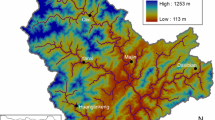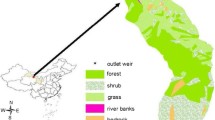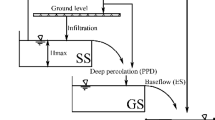Abstract
This study compares formal Bayesian inference to the informal generalized likelihood uncertainty estimation (GLUE) approach for uncertainty-based calibration of rainfall-runoff models in a multi-criteria context. Bayesian inference is accomplished through Markov Chain Monte Carlo (MCMC) sampling based on an auto-regressive multi-criteria likelihood formulation. Non-converged MCMC sampling is also considered as an alternative method. These methods are compared along multiple comparative measures calculated over the calibration and validation periods of two case studies. Results demonstrate that there can be considerable differences in hydrograph prediction intervals generated by formal and informal strategies for uncertainty-based multi-criteria calibration. Also, the formal approach generates definitely preferable validation period results compared to GLUE (i.e., tighter prediction intervals that show higher reliability) considering identical computational budgets. Moreover, non-converged MCMC (based on the standard Gelman–Rubin metric) performance is reasonably consistent with those given by a formal and fully-converged Bayesian approach even though fully-converged results requires significantly larger number of samples (model evaluations) for the two case studies. Therefore, research to define alternative and more practical convergence criteria for MCMC applications to computationally intensive hydrologic models may be warranted.










Similar content being viewed by others
References
Bahremand A et al (2007) WetSpa model application for assessing reforestation impacts on floods in Margecany–Hornad watershed, Slovakia. Water Resour Manage 21(8):1373–1391
Balin-Talamba D (2004) Hydrological behaviour through experimental and modeling approaches; Application to the Haute-Mentue catchment, PhD Thesis, Swiss Federal School of Technology of Lausanne
Balin-Talamba D, Parent E, Musy A (2010) Bayesian multiresponse calibration of TOPMODEL: application to the Haute-Mentue catchment, Switzerland. Water Resour Res 46:W08524
Bates BC, Campbell EP (2001) A Markov Chain Monte Carlo Scheme for parameter estimation and inference in conceptual rainfall-runoff modeling. Water Resour Res 37(4):937–947
Bates DM, Watts DG (1981) Parameter transformations for improved approximate confidence regions in nonlinear least squares. Ann Stat 9(6):1152–1167
Bates DM, Watts DG (1988) Nonlinear regression analysis and its applications. Wiley, New York
Beven KJ (2009) Comment on ‘‘Equifinality of formal (DREAM) and informal (GLUE) Bayesian approaches in hydrologic modeling; by Jasper A. Vrugt, Cajo J. F. ter Braak, Hoshin V. Gupta and Bruce A. Robinson. Stoch Environ Res Risk Assess 23:1059–1060
Beven K, Binley A (1992) The future of distributed models: model calibration and uncertainty prediction. Hydrol Process 6(3):279–298
Beven KJ, Smith PJ, Freer J (2008) So just why would a modeller choose to be incoherent? J. Hydrology 354:15–32
Beven K, Smith PJ, Wood A (2011) On the colour and spin of epistemic error (and what we might do about it). Hydrol Earth Syst Sci 15:3123–3133
Beven K, Smith PJ, Westerberg I, Freer J (2012) Comment on “Pursuing the method of multiple working hypotheses for hydrological modeling” by P. Clark et al. Water Resour Res 48:W11801
Binley A, Beven K (1991) Physically-based modelling of catchment hydrology: a likelihood approach to reducing predictive uncertainty. In: Rycroft MJ, Farmer DG (eds) Computer modelling in the environmental sciences, the institute of mathematics and its applications conference series. Clarendon Press, Oxford, pp 75–88
Blasone R-S, Madsen H, Rosbjerg D (2008a) Uncertainty assessment of integrated distributed hydrological models using GLUE with Markov chain Monte Carlo sampling. J Hydrology 353:18–32
Blasone RS et al (2008b) Generalized likelihood uncertainty estimation (GLUE) using adaptive Markov Chain Monte Carlo sampling. Adv Water Res 31:630–648
Blazkova S, Beven K (2009) A limits of acceptability approach to model evaluation and uncertainty estimation in flood frequency estimation by continuous simulation: Skalka catchment, Czech Republic. Water Resour Res 45:W00B16
Box GEP, Tiao GC (1973) Bayesian inference in statistical analysis. Addison-Wesley, Boston, MA
Boyle DP (2000) Multicriteria calibration of hydrological models. PhD Dissertation Thesis, University of Arizona
Clark MP, Kavetski D, Fenicia F (2012) Reply to comment by K. Beven et al. on “Pursuing the method of multiple working hypotheses for hydrological modeling”. Water Resour Res 48:W11802
Freni G, Mannina G (2009) Bayesian approach for uncertainty quantification in water quality modelling: the influence of prior distribution. J Hydrol 392:31–39
Gelman A, Carlin JB, Stern HS, Rubin DB (2004) Bayesian data analysis. Chapman & Hall/CRC, Boca Raton
Gupta HV, Sorooshian S, Yapo PO (1998) Toward improved calibration of hydrologic models: multiple and noncommensurable measures of information. Water Resour Res 34(4):751–764
Gupta HV, Wagener T, Liu Y (2008) Reconciling theory with observations: elements of a diagnostic approach to model evaluation. Hydrol Process 22:3802–3813
Hamilton S (2007) Just say NO to equifinality. Hydrol Process 21(14):1979–1980
Hills SE, Smith AFM (1992) Parameterization issues in Bayesian inference. In: Bernardo JM, Berger JO, Dawid AP, Smith AFM (eds) Bayesian statistics 4. Oxford University Press, Oxford, pp 227–246
Hong B, Strawderman RL, Swaney DP, Weinstein DA (2005) Bayesian estimation of input parameters of a nitrogen cycle model applied to a forested reference watershed, Hubbard Brook Watershed Six. Water Resour Res 41:W03007
Huard D, Mailhot A (2008) Calibration of hydrological model GR2M using Bayesian uncertainty analysis. Water Resour Res 44:W02424
Jeremiah E, Sisson S, Marshall L, Mehrotra R, Sharma A (2011) Bayesian calibration and uncertainty analysis of hydrological models: a comparison of adaptive Metropolis and sequential Monte Carlo samplers. Water Resour Manage 47:W07547
Jin X, Xu C-Y, Zhang Q, Singh VP (2010) Parameter and modeling uncertainty simulated by GLUE and a formal Bayesian method for a conceptual hydrological model. J Hydrol 383:147–155
Johnston PR, Pilgrim DH (1976) Parameter optimization for watershed models. Water Resour Res 12(3):477–486
Kavetski D, Franks SW, Kuczera G (2002) Confronting input uncertainty in environmental modeling. In: Duan Q, Gupta HV, Sorooshian S, Rousseau AN, Turcotte R (eds) Calibration of watershed models. AGU, Washington, DC, pp 49–68
Kavetski D, Kuczera G, Franks SW (2006) Bayesian analysis of input uncertainty in hydrological modeling: 1. Theory. Water Resour Res 42:W03407. doi:10.1029/2005WR004368
Kuczera G (1983) Improved parameter inference in catchment models: 1. Evaluating parameter uncertainty. Water Resour Res 19(5):1151–1162
Kuczera G, Mroczkowski M (1998) Assessment of hydrologic parameter uncertainty and the worth of multiresponse data. Water Resour Res 34(6):1481–1489
Kuczera G, Parent E (1998) Monte Carlo assessment of parameter uncertainty in conceptual catchment models: the Metropolis algorithm. J Hydrol 211(1–4):69–85
Kuczera G, Kavetski D, Franks S, Thyer M (2006) Towards a Bayesian total error analysis of conceptual rainfall-runoff models: characterising model error using storm-dependent parameters. J Hydrol 331(3–4):161–177
Laio F, Tamea S (2007) Verification tools for probabilistic forecasts of continuous hydrological variables. Hydrol Earth Syst Sci 11(4):1267–1277
Lamb R, Beven KJ, Myrabø S (1998) Use of spatially distributed water table observations to constrain uncertainty in a rainfall–runoff model. Adv Water Res 22(4):305–317
Legates DR, McCabe GJ (1999) Evaluating the use of ‘‘goodness-of-fit’’ measures in hydrologic and hydro-climatic model evaluation. Water Resour Res 35:233–241
Li L, Xia J, Xu C-Y, Singh VP (2010) Evaluation of the subjective factors of the GLUE method and comparison with the formal Bayesian method in uncertainty assessment of hydrological models. J Hydrol 390:210–221
Liu YB, Gebremeskel S, De Smedt F, Hoffmann L, Pfister L (2003) A diffusive transport approach for flow routing in GIS-based flood modeling. J Hydrol 283(1–4):91–106
Liu Y, Freer J, Beven K, Matgen P (2009) Towards a limits of acceptability approach to the calibration of hydrological models: extending observation error. J Hydrol 367:93–103
Madsen H (2000) Automatic calibration of a conceptual rainfall–runoff model using multiple objectives. J Hydrol 235:276–288
Mantovan P, Todini E (2006) Hydrological forecasting uncertainty assessment: incoherence of the GLUE methodology. J Hydrol 130(1–2):368–381
Marshall L, Nott D, Sharma A (2007) Towards dynamic catchment modelling: a Bayesian hierarchical mixtures of experts framework. Hydrol Process 21:847–861
Montanari A (2005) Large sample behaviors of the generalized likelihood uncertainty estimation (GLUE) in assessing the uncertainty of rainfall–runoff simulations. Water Resour Res 41:W08406
Montanari A (2007) What do we mean by “uncertainty”? The need for a consistent wording about uncertainty in hydrology. HPToday 21(6):841–845
Montanari A et al (2011) Interactive comment on “On the colour and spin of epistemic error (and what we might do about it)” by K. Beven. Hydrol Earth Syst Sci Discuss 8:C2885–C2891
Moore RJ (1985) The probability-distributed principle and runoff production at point and basin scales. Hydrol Sci 30(2):273–297
Moradkhani H, Sorooshian S, Gupta HV, Houser PR (2005) Dual state-parameter estimation of hydrological models using ensemble Kalman filter. Adv Water Resour 28:135–147
Mroczkowski M, Raper GP, Kuczera G (1997) The quest for more powerful validation of conceptual catchment models. Water Resour Res 33:2325–2335
Qian SS, Stow CA, Borsuk ME (2003) On Monte Carlo methods for Bayesian inference. Ecol Model 159:269–277
Razavi S et al (2010) Reducing the computational cost of automatic calibration through model pre-emption. Water Resour Res 46(11):W11523
Refsgaard JC (1997) Parameterisation, calibration and validation of distributed hydrological models. J Hydrol 198:69–97
Reichert P (1997) On the necessity of using imprecise probabilities for modelling environmental systems. Water Sci Technol 36(5):149–156
Renard B, Kavetski D, Kuczera G, Thyer M (2010) Understanding predictive uncertainty in hydrologic modeling: the challenge of identifying input and structural errors. 2010(46):W05521
Renard B et al (2011) Toward a reliable decomposition of predictive uncertainty in hydrological modeling: characterizing rainfall errors using conditional simulation. Water Resour Res 47:W11516
Romanowicz RJ, Beven KJ, Tawn J (1994) Evaluation of predictive uncertainty in nonlinear hydrological models using a Bayesian approach. In: Barnett V, Turkman KF (eds) Statistics for the environment 2, water related issues. Wiley, Chichester, pp 297–315
Schaefli B, Talamba DB, Musy A (2007) Quantifying hydrological modeling errors through a mixture of normal distributions. J Hydrol 332:303–315
Seber GA, Wild CJ (1989) Nonlinear regression. John Wiley and Sons, New York (NY)
Shafii M, Smedt FD (2009) Multi-objective calibration of a distributed hydrological model (WetSpa) using a genetic algorithm. Hydrol Earth Syst Sci 13:2137–2149
Sorooshian S, Duan Q, Gupta VK (1993) Calibration of rainfall-runoff models: application of global optimization to the Sacramento Soil Moisture accounting model. Water Resour Res 29:1185–1194
Stedinger JR, Vogel RM, Lee SU, Batchelder R (2008) Appraisal of the generalized likelihood uncertainty estimation (GLUE) method. Water Resour Res 44:W00B06
Thiemann M, Trosset M, Gupta HV, Sorooshian S (2001) Bayesian recursive parameter estimation for hydrologic models. Water Resour Res 37(10):2521–2535
Thyer M et al (2009) Critical evaluation of parameter consistency and predictive uncertainty in hydrological modeling: a case study using Bayesian total error analysis. Water Resour Res 45:W00B14
Vrugt JA, Gupta HV, Bastidas LA, Bouten W, Sorooshian S (2003a) Effective and efficient algorithm for multiobjective optimization of hydrologic models. Water Resour Res 39(8):1214. doi:10.1029/2002WR001746
Vrugt JA, Gupta HV, Bouten W, Sorooshian S (2003b) A Shuffled Complex Evolution Metropolis algorithm for optimization and uncertainty assessment of hydrologic model parameters. Water Resour Res 39(8):1201. doi:10.1029/2002WR001642
Vrugt JA, ter Braak CJF, Gupta HV, Robinson BA (2008) Equifinality of formal (DREAM) and informal (GLUE) Bayesian approaches in hydrologic modeling? Stoch Environ Res Risk Assess 44:1–16
Vrugt JA et al (2009) Accelerating Markov chain Monte Carlo simulation by differential evolution with self-adaptive randomized subspace sampling. Int J Nonlinear Sci Numer Simul 10(3):273–290
Wagener T et al (2001) A framework for development and application of hydrological models. Hydrol Earth Syst Sci 5(1):13–26
Wang Z-M, Batelaan O, De Smedt F (1996) A distributed model for water and energy transfer between soil, plants and atmosphere (WetSpa). Phys Chem Earth 21(3):189–193
Wei W, Clark JS, Vose JM (2010) Assimilating multi-source uncertainties of a parsimonious conceptual hydrological model using hierarchical Bayesian modeling. J. Hydrol 394:436–446
Yadav M, Wagener T, Gupta H (2007) Regionalization of constraints on expected watershed response behavior for improved predictions in ungauged basins. Adv Water Resour 30(8):1756–1774
Yang J, Reichert P, Abbaspour KC, Yang H, Xia J (2008) Comparing uncertainty analysis techniques for a SWAT application to the Chaohe Basin in China. J Hydrol 358:1–23
Yapo PO, Gupta HV, Sorooshian S (1998) Multi-objective global optimization for hydrologic models. J Hydrol 204(1–4):83–97
Yilmaz KK, Gupta HV, Wagener T (2008) A process-based diagnostic approach to model evaluation: application to the NWS distributed hydrologic model. Water Resour Res 44:W09417
Acknowledgments
This research was supported with first author funding provided by Bryan Tolson’s NSERC Discovery Grant. The authors would like to acknowledge Dr. Jasper A. Vrugt for providing the code of his DREAM algorithm used in this study and the four anonymous reviewers for their helpful comments that have improved the paper.
Author information
Authors and Affiliations
Corresponding author
Appendix: review of Bayesian inference procedure
Appendix: review of Bayesian inference procedure
This appendix provides a summary of the Bayesian formulation used in this paper, and the details can be found in previous studies (Balin-Talamba et al. 2010; Schaefli et al. 2007). We assume the AR-based formulation as follows:
where Y i and Y sim i are the observed and simulated values for the model response at time step i, θ is the model parameters vector, X is the model inputs vector, ρ is the lag-one AR parameter, ɛ i = (Y i − Y sim i (θ, X)) is the residual between observation and model prediction at time step i (and ɛ 0 = 0), and δ i is random error term:
with σ 2 j being the residual variance for response j, here considered unknown and should be estimated. If we consider J responses, then J parameters (representing error variance for J responses) need to be estimated in the Bayesian inference methodology. Under the assumption of multiple and statistically independent responses, the combined statistical likelihood function for multiple responses is simply the product of the individual likelihood functions:
where δ j,i = ɛ j,i − ρɛ j,i−1 for observation set j and time step i (note that ɛ j,0 = 0), respectively; J is the number of observation sets, and t j is the number of time steps for each observation set j. In order to derive the posterior distribution of parameters, a bounded uniform prior distribution is considered for θ over prior feasible range, and the prior distribution of error variance is also considered to be Jeffrey non-informative distribution as follows:
Using such prior distributions enables us to integrate out the error variances, and the Bayesian formulation results in the joint posterior distributions from which the marginal distribution of model parameters and error variances can be estimated conditioned on the observed data Y. Alternatively, we can use MCMC sampling to directly take samples from the posterior distributions, all of which are contained in the chain. In MCMC implementations, the acceptance/rejection criterion ratio (between posterior densities of the new candidate and old current samples) is used to accept/reject the candidate to be added to the chain. In the multi-criteria Bayesian formulation, let σ 2 j,current and σ 2 j,candidate be the error variance of the current and candidate solutions, respectively, which are estimated based on the residuals after running the simulation model. Also assume the quantity \( S_{j} = 0.5\sum\nolimits_{i = 1}^{{t_{j} }} {\delta_{j,i}^{2} } \), such that \( S_{j,current} \) and \( S_{j,candidate} \) be the values for the current and the candidate solutions, respectively. The final form of the acceptance/rejection criterion can then be shown as follows:
Rights and permissions
About this article
Cite this article
Shafii, M., Tolson, B. & Matott, L.S. Uncertainty-based multi-criteria calibration of rainfall-runoff models: a comparative study. Stoch Environ Res Risk Assess 28, 1493–1510 (2014). https://doi.org/10.1007/s00477-014-0855-x
Published:
Issue Date:
DOI: https://doi.org/10.1007/s00477-014-0855-x




